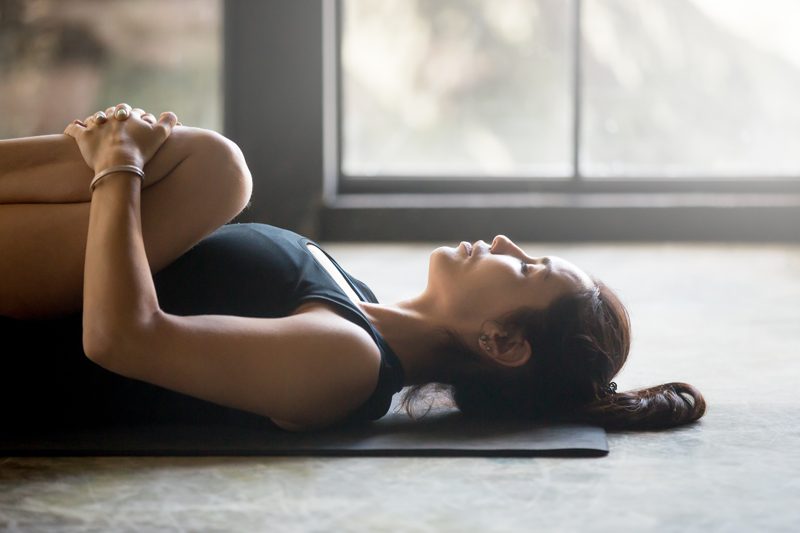The knee joint is made up of bone, ligaments, and cartilage. As the largest and most complex joint in the body, it allows us to kneel, sit, run, walk, stand upright, and even crawl on the ground. However, the knee joint can also cause a lot of problems, particularly if we don’t look after it; In the UK, the knee receives more orthopaedic surgeries than any other bone in the body. Additionally, knee pain is the second greatest cause of chronic pain, with almost one-third of Brits being affected by the issue. Knee pain can be caused by a number of things including osteoarthritis, sports injuries, and everyday wear and tear. Alongside physiotherapy, many doctors are now recommending yoga as part of the healing process. However, if we don’t take care of our knees during yoga, we are at risk of making pre-existing conditions worse – particularly if we don’t use a supportive yoga mat. In this article, we explore the best ways to keep your knees safe during yoga.
Choose the Right Style
If you already suffer from knee pain, it’s important to consider which style of yoga will be best suited to your knees. Before choosing a class, consider the educational background of the instructor. For best results, find someone with a background in yoga therapy or orthopaedic exercise. This way, the instructor will be able to give you expert advice on how to keep your knees safe.
Choosing the right style of yoga is also important. Slower paced classes allow you to pay more attention to the alignment of your joints. If you suffer from a pre-existing injury, this is important. Slowly moving into a posture will allow you to assess the situation and pick up on pain before it goes too far. If the position becomes uncomfortable, you can exit it before you exacerbate your condition.
Fast-paced classes may not be the best choice if you’re suffering from knee pain. Often, classes of this nature include jumping and dynamic movement. Not only will this place strain on the joints, but it will also make it difficult to spot pain early on. If a slow-paced class isn’t an option, talk to your instructor about how to modify unsuitable poses. Even with modifications, some postures may be unsuitable. In this case, sit out these poses instead of pushing your body too far.
Know What a Safe Stretch Feels Like
If you practice yoga, it’s important to know what a safe stretch feels like. Even without a pre-existing knee condition, stretching has the potential to damage the joints if it’s not done correctly. When stretching, sensation in the muscle above the knee joint is fine; however, a sensation of pulling under the knee cap or by the sides of the knee should be avoided. If you feel this, release the stretch until the sensation has gone.
If you’re a regular yogi, you may have experienced this during Lotus Pose. During this asana, the knee must be fully flexed to stay safe. Often, practitioners have no problem with moving the first leg into position but struggle with the second. In this case, forcing the second leg into position may tear the medial meniscus and cause lasting damage. If you notice a pulling sensation under the knee cap, back away from the position to avoid causing injury.
Modifications to Keep Your Knees Safe
As well as considering the points above, you can modify specific asanas to keep the knees safe. These modified poses can be a great option for those with knee pain, or for those looking to minimise stress on the joints.
Use a Support During Hero Pose
During Hero Pose, sit on a folded blanket, block, or bolster to take compression off the knee joints. To find the right position, you may need to experiment with the height of your props. As a rule of thumb, taller practitioners will need a taller prop, while shorter yogis may be suited to a folded blanket.
Sit on a Block During Squats
If you’re experiencing knee pain, you should avoid lowering your hips below your knees. With this in mind, you may steer away from squatting positions such as Garland Pose; however, you don’t need to! To keep these positions safe on the knees, use a stool or prop whilst you practice. Before you begin, place a stool or tall yoga block underneath your bottom. During the pose, rest your bottom on the block to reduce pressure on the knees.
Use a Bolster During Child’s Pose
During Child’s Pose, use a bolster for support. To reduce pressure on the knees, stack two under the abdomen from your pubic bone to your chest. When you practice the asana, come into the position as normal and rest your body on the support. Your head should be turned to one side and your arms can hug the top of the prop.
Raise Your Kneecaps During Cat Cow
If you suffer from knee pain, Cat Cow Pose can feel uncomfortable. To keep the knees safe, place a folded blanket under the shins to levitate your kneecaps. For best results, the blanket should be about an inch thick.
Place a Block Between Your Shins in Chair Pose
In Chair Pose, hug a block between your shins to keep the knees safe. Hold the block just below your knees at its narrowest width. This modification will encourage safe alignment and minimise pressure on the joints.
In Summary
To keep your knees safe during yoga, take note of the steps above. Some practitioners prefer to wear yoga shorts when suffering from knee pain; this way, they can keep a close eye on their alignment throughout the class. As with any type of exercise, you should get your doctors recommendation before using yoga after an injury. As well as discussing any restrictions and guidelines, your doctor can give you advice on your range of motion to minimise further injury.

